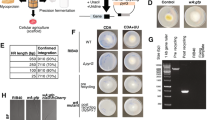Abstract
EARLIER workers1, who observed the excretion of the tryptophane metabolites, kynurenine and xanthurenic acid, by the rat and the rabbit under conditions suggestive of vitamin B deficiency, failed, however, to realize its physiological significance. It was not until Lepkovsky et al. 2 isolated and identified the pigment metabolite, xanthurenic acid, from the urine of pyridoxine-deficient rats receiving extra-dietary tryptophane, that the role of this vitamin in the metabolism of the amino-acid was unequivocally established. Since then, a number of reports have appeared of the conversion of tryptophane to xanthurenic acid, kynurenine, hydroxykynurenine, etc., by pyridoxine-deficient rats, rabbits and dogs1,3. In 1945, Sarma4 found that the rice moth larva (Corcyra cephalonica St.), maintained on a pyridoxine-deficient diet containing added tryptophane, excreted yellow-coloured fæces. This was about the first and only report on the role of pyridoxine in tryptophane metabolism in insects and established a striking parallel in the metabolism of the amino-aoid between mammals and insects. Pyridoxine had earlier been shown by the same author5 to be an essential vitamin for the growth of the larva. The excretory pigment, however, was not characterized; but it was shown that it was not identical with xanthurenic acid, from the negative test it gave with iron salts, Tryptophane, has also been shown to be the precursor of the pigments, ommochromes, found in the eyes and tissues of certain insects, and the production of the pigments; appears to be controlled by genes6. Kynurenine and hydroxykynurenine, which are normal intermediates in this conversion, and kynurenic acid, which is derived from kynurenine by oxidative deamination consequent on a gene mutation, have all been identified and isolated6–9. The present communication outlines further studies of the metabolism of tryptophane in the rice moth larva. The effect of the incorporation of DL-kynurenine and of D-tryptophane in the diet instead of DL-tryptophane and the chemical identity of the excretory pigment have been investigated.
This is a preview of subscription content, access via your institution
Access options
Subscribe to this journal
Receive 51 print issues and online access
$199.00 per year
only $3.90 per issue
Buy this article
- Purchase on Springer Link
- Instant access to full article PDF
Prices may be subject to local taxes which are calculated during checkout
Similar content being viewed by others
References
Dalgliesh, C. E., Quart. Rev. Chem. Soc., 5, 227 (1951).
Lepkovsky, S., Roboz, E., and Haagen-Smit, A. J., J. Biol. Chem., 149, 195 (1943).
Dalgliesh, C. E., Biochem. J., 52, 3 (1952).
Sarma, P. S., Proc. Soc. Exp. Biol. Med., 58, 140 (1945).
Sarma, P. S., Ind. J. Med. Res., 31, 165 (1943).
Wigglesworth, V. B., “Ann. Rev. Biochem.”, 18, 595 (1949).
Butenandt, A., Weidel, W., Weichert, R., and von Derjugin, W., Z. physiol. Chem., 279, 27 (1943).
Butenandt, A., Weidel, W., and Schlossberger, H., Z. Naturforsch., 4 b, 242 (1949).
Hirata, Y., Nakanishi, K., and Kikkawa, H., Science, 112, 307 (1950).
Kallio, R. E., and Berg, C. P., J. Biol. Chem., 181, 333 (1949).
Shanmugasundaram, E. R. B., and Sarma, P. S., J. Sci. Indust. Res., 12 B, 245 (1953).
Birkhofer, L., and Wetzel, R., Z. physiol. Chem., 264, 31 (1940).
Krebs, H. A., “The Enzymes”, edited by Sumner, J. B., and Myrback, K., 2, Pt. 1, 499 (Academic Press, Inc., New York, 1951).
Mason, M., and Berg, C. P., J. Biol. Chem., 188, 783 (1951).
Author information
Authors and Affiliations
Rights and permissions
About this article
Cite this article
SUNDARAM, T., SARMA, P. Tryptophane Metabolism in Rice Moth Larva (Corcyra cephalonica St.). Nature 172, 627–628 (1953). https://doi.org/10.1038/172627b0
Issue Date:
DOI: https://doi.org/10.1038/172627b0
This article is cited by
Comments
By submitting a comment you agree to abide by our Terms and Community Guidelines. If you find something abusive or that does not comply with our terms or guidelines please flag it as inappropriate.



